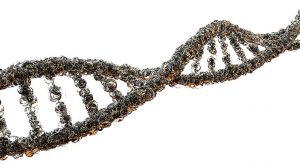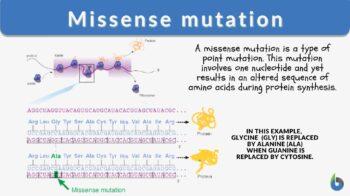
Missense mutation
n., plural: missense mutations
[ˌmɪsˈsɛns mjuˈteɪʃən]
Definition: a point mutation resulting in the substitution of an amino acid
Table of Contents
What is a missense mutation? Literally speaking, a mutation that changes the meaning of the encoded gene sequence is the missense mutation. Let’s now understand missense mutation in detail.
Missense Mutation Definition
A missense mutation is a type of point mutation or single base mutation that replaces one nucleotide of the codon on the DNA with other nucleotides, which eventually results in coding a different amino acid in the protein. The resultant amino acid substitution may result in either nonfunctional protein or may remain unaffected by the altered amino acid. The functionality of the resultant protein will depend on whether the changes that occur due to mutation are ‘conservative‘ or ‘nonconservative’.
Interestingly, when the change in the nucleotide of the codon results in the formation of the stop codon, the mutation is known as ‘nonsense’ mutation. Due to the formation of the stop codon, the nonsense mutation results in the premature termination of protein formation. The mutations, i.e., missense mutation and nonsense mutation, are point mutations or substitution mutations wherein one nucleotide is changed during the mutation process. Hence, it is essential to understand the difference between Missense mutation and Nonsense mutation (Table 1).
Table 1: Difference between Missense mutation and Nonsense mutation | |
|---|---|
| Missense mutations | Nonsense mutations |
| Define missense mutation: It is a point mutation wherein one nucleotide is replaced by another, resulting in a change in the amino acid formed. | Define nonsense mutation: It is a point mutation wherein one nucleotide is replaced by another nucleotide; however, the resultant codon formed is a stop codon (the three stop codons are UAG, UAA, and UGA) which terminates the formation of amino acid formation |
| Missense point mutation never results in the formation of the Stop codon | A nonsense mutation in a gene always results in the formation of the Stop codon |
| This mutation results in the formation of different amino acid sequence | This mutation results in the formation of shortened amino acid sequence, i.e., truncated protein |
| Resultant protein may be either functional or nonfunctional | Resultant proteins are nonfunctional |
| Examples: Sickle cell anaemia, Superoxide dismutase (SOD) mediated amyotrophic lateral sclerosis (ALS) | Example: Dravet syndrome |
Data Source: Dr. Amita Joshi of Biology Online.
At this stage, one can answer, which type of mutation always produces a stop codon?
The third type of point mutation is a silent mutation. Silent mutation, by definition, is a point mutation wherein change in a single nucleotide in a protein-coding gene sequence does not affect the amino acid sequence in the resultant protein.
A diagrammatic representation of the difference between all the three types of point mutations, i.e., missense mutation, nonsense mutation, and silent mutation, is shown below (Figure 1).
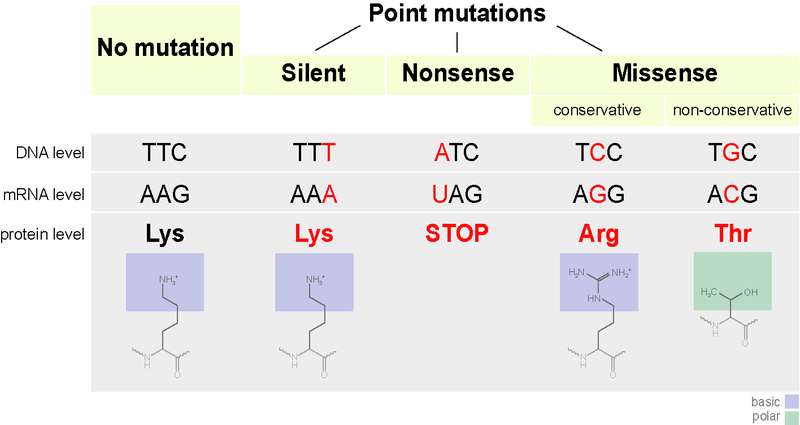
Missense mutation may be caused spontaneously or due to any mutagen. Usually, missense mutation occurs spontaneously during DNA replication, wherein point mutations within a DNA sequence are seen to replace a nucleotide at a particular DNA sequence. However, mutagens like Reactive oxygen species (ROS), X-rays, and UV radiations may induce missense mutations. X-rays and UV radiations possess high energy and ionize the molecules. The tautomeric shift of the nucleotides is the most common mechanism involved in a missense mutation.
All the nucleotides occur in keto and enol form, wherein keto form is more prevalent while enol form is rare. Tautomeric shift changes in form eventually affect the complementary base pairing with the nucleotide. This further alters the mRNA sequence after translation and is reflected as the formation of different amino acids. Due to this transition of one nucleotide by another, point mutations are also referred to as transition mutations.
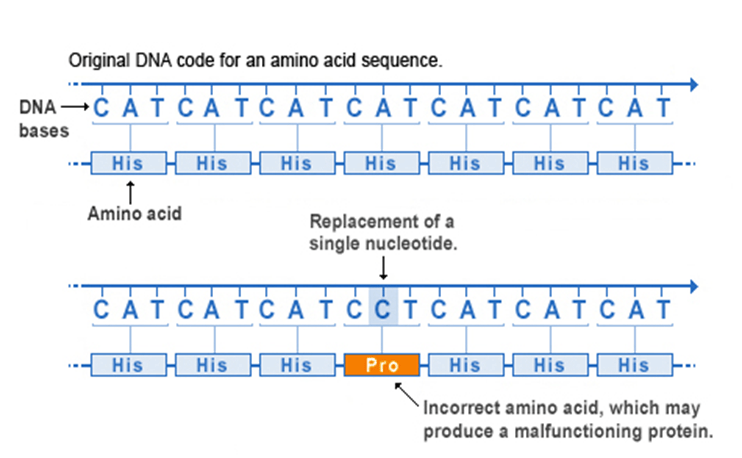
Watch this vid for the definition of missense mutation.
Biology definition:
A missense mutation is a form of point mutation resulting in a codon that codes for a different amino acid, and thus, causes the synthesis of a protein with an altered amino acid sequence during translation.
Overview:
A mutation is a change in the nucleotide sequence of a gene or a chromosome. When there is only one nucleotide involved, it is particularly referred to as a point mutation. Point mutation occurring in noncoding sequences often does not result in an altered amino acid sequence during translation. However, if a mutation in the promoter sequence of a gene occurs, the effect may be apparent since the expression of the gene may cause changes in the amino acid sequence, as well as the structure and function of the protein product. Point mutations may be classified based on functionality: (1) nonsense mutation, (2) missense mutation, and (3) silent mutation. A missense mutation may lead to the synthesis of a protein that is nonfunctional. For instance, in sickle-cell disease, the 20th nucleotide of the gene for the beta chain of hemoglobin on chromosome 11 is changed from the codon GAG to GTG so that when translated the 6th amino acid is now a valine instead of glutamic acid.
Compare nonsense mutation, silent mutation.
See point mutation, mutation, substitution mutation.
Substitution of Protein from DNA Mutations
Now we know what a missense mutation does. A missense mutation is a nucleotide base substitution mutation that results in new amino acid, also known as nonsynonymous substitution. Thus, missense mutation may be a conservative mutation or nonconservative mutation. Conservative and nonconservative mutations are types of amino acid mutations.
Types of missense mutations are:
- Conservative mutation
- Here, the resultant amino acid is similar in function and shape to the amino acid being replaced.
- As a result, this type of mutation results in a protein with almost identical functionality and shape as that of the original protein.
- The conservative mutation results in a less drastic change in the protein functionality.
- Conservative mutations are nature’s natural selection tool that enables organisms to survive through difficult environmental conditions.
- Nonconservative mutation
- Here, the resultant amino acid is completely different from that of the original amino acid.
- As a result of this type of mutation, the nonconservative mutation results in a completely different protein with altered functionality and shape.
- Nonconservative mutations are normally observed wherein a polar amino acid replaces a non-polar amino acid.
At this point, what do you think? Are mutations always harmful? No! An understanding of conservative and nonconservative mutations provides insight that mutations are not always harmful. In fact, certain mutations may not change the mutant protein functionality.
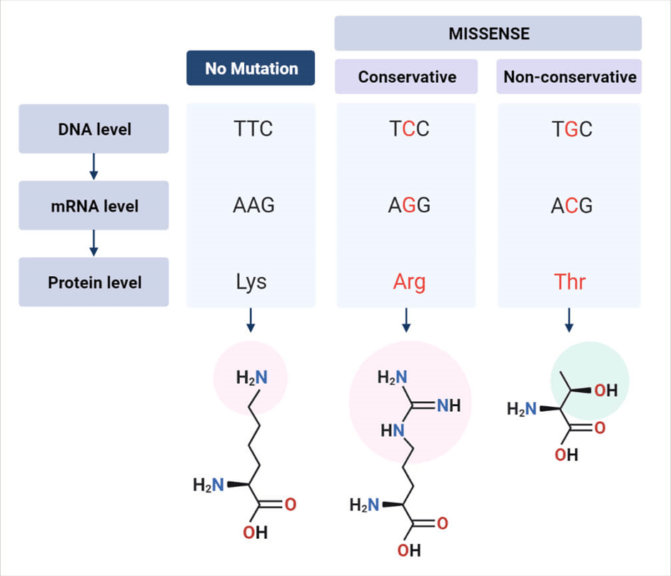
Missense Mutation Example
In missense mutation, base substitution occurs with a different nucleotide, resulting in different amino acid formations. This can be understood with the help of a simplified example mentioned below.
| Wild type mRNA: | 5′ GCU GGA GCA CCA GGA CAA GAU GGA 3′ |
| Wild type polypeptide: | N Ala Gly Ala Pro Gly Gln Asp Gly C |
| Missense mutation: | 5′ GCU GGA GCA CCA AGA CAA GAU GGA 3′ N Ala Gly Ala Pro Arg Gln Asp Gly C |
The most widely studied missense mutation is that of sickle cell anemia. Sickle cell anemia is a genetically inherited blood disease wherein the red blood cells (RBCs) become crescent or “sickle” shaped. Normally, RBCs are flexible and disc-shaped, which aids in the unobstructed flow of the blood. However, sickle-shaped RBCs in sickle cell anemia may result in a blockade, which obstructs the blood flow and cause pain (also referred to as pain cries), stroke, infection, ocular problems, etc. (Figure ). Also, such sickle-shaped RBCs have a short life compared to the normal RBCs, as a result of which the patient is persistently in shortage of RBCs.
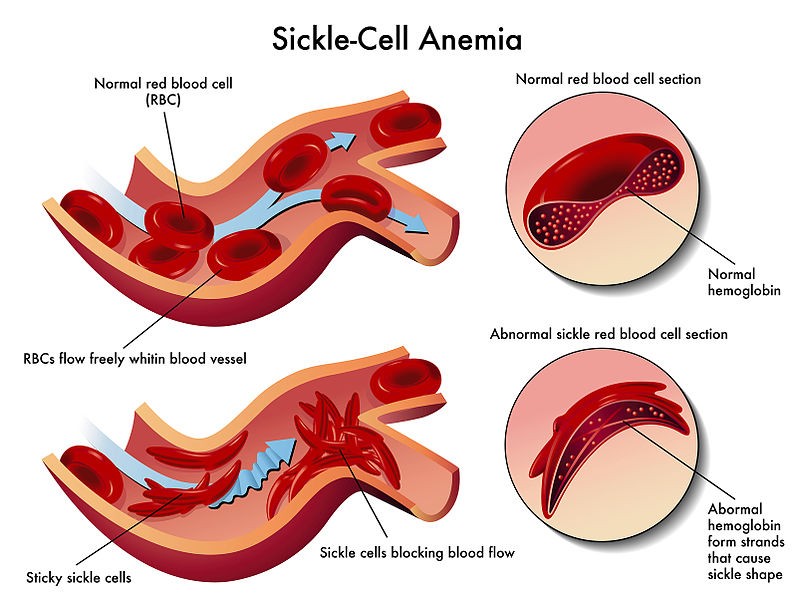
In sickle cell anemia, mutation results in the replacement of glutamic acid (GAG) with valine (GTG) amino acid. This type of mutation is also called Single Nucleotide Polymorphism or SNPs. This mutation in sickle cell anemia is a nonconservative mutation that results in changing the shape of the RBCs. Sickle cell anemia missense mutation occurs in the β globin gene (HbS alleles) and is inherited as a recessive trait. Interestingly, the same mutation in dominant inheritance results in resistance to malaria.
- Another example is cystic fibrosis missense mutation is seen in the transmembrane conductance regulator (CFTR) gene of cystic fibrosis patients.
- An inherited tp53 mutation, also known as Li-Fraumeni syndrome, is a rare genetic condition wherein the probability of all types of cancer is increased. p53 is a tumour suppressor gene, tp53 missense mutation results in inactivation of tp53 gene and therefore, the likelihood of cancer induction in such cases increases. As a result, the majority of cancers cases exhibit p53 missense mutation.
How Do Mutations Affect an Organism?
The missense mutation can affect living organisms in multiple ways; some of them are mentioned below:
- Pathogenesis of certain diseases involves missense mutation. Therefore, an understanding of the etiology of the disease can be helpful in its management.
- For the treatment and prevention of genetic disorders, induced missense mutations are used as molecular therapy.
- Induced missense mutations using mutagens can be used as a tool to target specific cancers.
- Missense mutations are nature’s selection tool that enables an organism to survive through an undesirable environment and ecosystem.
- Missense mutations are also used as a tool for crop improvement by carrying out mutation breeding.
- Missense mutations are also helpful in understanding the stability and interaction profile of the proteins.
Experimental Analysis
Following methods can be employed to identify point mutations or single nucleotide experimentally –
- DNA sequencing, wherein each nucleotide in the gene sequence is identified and compared with the original gene.
- DNA hybridization methods, wherein single-stranded DNA is used to identify the mutations on the complementary DNA strand.
- Restriction enzyme digestion or hybridization
Based on the above techniques, the following diagnostic tests are employed to identify missense mutation and any diseases involved thereof-
- DNA microarray technology
- Allele-Specific Oligonucleotides (ASO)
- Single-Strand Conformational Polymorphism (SSCP)
- Denaturing Gradient Gel Electrophoresis (DGGE)
- Protein Truncation Test (PTT)
- Heteroduplex analysis
- Nucleotide sequencing
Try to answer the quiz below to check what you have learned so far about missense mutation.
References
- Kryukov, G. V., Pennacchio, L. A., & Sunyaev, S. R. (2007). Most rare missense alleles are deleterious in humans: implications for complex disease and association studies. American journal of human genetics, 80(4), 727–739. https://doi.org/10.1086/513473
- Sinclair A. (2002). Genetics 101: detecting mutations in human genes. CMAJ : Canadian Medical Association journal = journal de l’Association medicale canadienne, 167(3), 275–279.
- Zhang, Z., Miteva, M. A., Wang, L., & Alexov, E. (2012). Analyzing effects of naturally occurring missense mutations. Computational and mathematical methods in medicine, 2012, 805827. https://doi.org/10.1155/2012/805827
- Zhou, X., Iversen, E. S., Jr, & Parmigiani, G. (2005). Classification of Missense Mutations of Disease Genes. Journal of the American Statistical Association, 100(469), 51–60. https://doi.org/10.1198/016214504000001817
©BiologyOnline.com. Content provided and moderated by Biology Online Editors.

